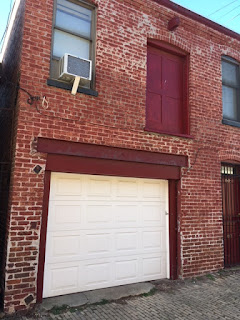My Washington semester gave me the chance to be present at the March for Our Lives, the massive rally against gun violence organized in the wake of yet another mass shooting, this one at Douglas High School in Parkland, Florida. Parkland students spoke movingly of their experiences, both at the rally and in media interviews. Attendance estimates ranged from 200,000 to 800,000--Washington Metro reported their ridership on the day at 558,375, comparable to a presidential inauguration-- but whatever it was, it was a lot.
My own experience was rather prosaic. I've been attending a Lutheran church in DC, and local Lutherans met up at a church near the site. From there we walked down Indiana Avenue, joining streams of pedestrian traffic that merged to become rivers, until we could make no further progress.
I stood there for an hour or so, hearing some of the speeches and the music, but mostly drawing energy from the crowds around me.
Everyone seemed happy to be there, though they might have preferred a better vantage point. White and black, groups and individuals, Washingtonians and those who came to town for the event were gracious to each other; we'd occasionally move a little to allow a line of people through, either in hopes of finding some Northwest passage to the front, or else to get water. Signs and shirts were not entirely, but predominantly positive. Eventually, after about 90 minutes, I caught one of the lines and surfed it out of there. If you watched on TV you saw and heard more than I did.
I'm glad I went anyway, partly for the historic nature of the event--this might be the biggest thing I've ever been part of--but mostly to stand up and be counted. I'm not just curious; I am angry. Guns have never been central as an issue to me or to this project like economic opportunity, environmental sustainability, community inclusion and place-making. But maybe it should be. A community must be safe to be successful, and people need to feel safe as a basic prerequisite for any community.
So is common conversation. The issue of gun violence has for decades lacked an inclusive conversation; any policy suggestions are met with surly badassery, cultural clannishness to the point of paranoia, and legislative stonewalling. The March for Our Lives gave people--a lot of people--in Washington and around the country the opportunity to demand an end to this, and instead opportunities to discuss the terms for living together.
I wrote this about gun politics 2 1/2 years ago, and don't have much else to say. I don't have a brief for any specific policy measure. A 2017 New York Times column by Nicholas Kristof contains a number of specific proposals suggestions which would make reasonable starting points; I'd also like to look at civil liability for private sales. I am dubious about the efficacy of local ordinances, given the porousness of city boundaries. But as Justice Robert H. Jackson said, "The Constitution is not a suicide pact." We as a country can do a lot better, and it's way past time to start.
P.S. I was nonplussed by a quote in the Post article (cited below) from Robert Johnson of New York City, who attended a counter-protest in Boston: If you run over someone with a car, they don't blame the car. But if someone is shot, they immediately blame the guns. Johnson is obviously ignorant of efforts in cities across the country to redesign streets for pedestrian safety. New York City, his hometown, has been in the forefront of these efforts. You'd have to be willfully oblivious to remain unaware. We have a long way to go to make our streets truly safe for everyone, but we are having the conversations. We should be having the same conversations about guns. There is no excuse not to.
SEE ALSO:
Peter Jamison, Joe Heim, Lori Aratani and Marissa J. Lang, "In Grief, Marching for Change," Washington Post, 25 March 2018, A1 & 19
Natalie Kroovand Hipple, "The Way Cities Report Gun Violence is All Wrong," Washington Post, 26 March 2018
Kristof's list:
- background checks: 22 percent of guns are obtained without one
- protection orders: keep men who are subject to domestic violence protection orders from having guns
- ban under-21s: a ban on people under 21 purchasing firearms (this is already the case in many states)
- safe storage: these include trigger locks as well as guns and ammunition stored separately, especially when children are in the house
- straw purchases: tighter enforcement of laws on straw purchases of weapons, and some limits on how many guns can be purchased in a month
- ammunition checks: experimentation with a one-time background check for anybody buying ammunition
- end immunity: end immunity for firearm companies; that's a subsidy to a particular industry
- ban bump stocks: a ban on bump stocks of the kind used in Las Vegas to mimic automatic weapon fire
- research 'smart guns:' "smart guns" fire only after a fingerprint or PIN is entered, or if used near a particular bracelet













































